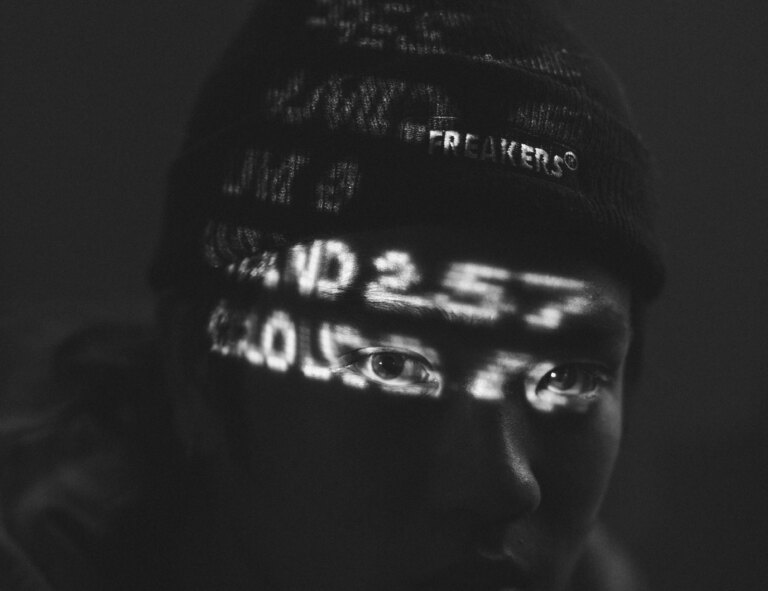

Different authors converge on the notion of a collective subconscious to explain the recurrence of symbols and archetypes across time and space. The work of Mexican artist Alejandro García Contreras is deeply attuned to that flow of universal consciousness shared by humanity across eras and geographies—a collective subconscious that, as Carl Jung described, is not a static archive but a living field of imagination continually reshaping itself through the “original instructions” already embedded in the human psyche.
The best art often begins with this kind of soul call, transforming creation into a mission. For Contreras, that call came early, through an image he encountered as a child in a book given to him by his grandfather—a mystical man and shaman. The book, an encyclopedia of the occult exploring timeless questions through myth and enigma, became, as the artist describes it, “a kind of guide or amulet for my imagination.” In the chapter on Vampirism and Lycanthropy, Contreras discovered a terrifying yet seductive image: a harpy-like woman attacking a naked man. “That image would never leave me,” he tells Observer. “That erotic undertone—imperceptible to me at the time—was etched into my memory.”
The image, however, bore no signature or caption. Only years later, thanks to Google, did Contreras learn it was a painting by Bolesław Biegas, a visionary Polish artist from the early twentieth century. His connection to Biegas deepened when, during an Art Explora residency in Paris, Contreras found himself—by both chance and intention—at the Polish Library in Paris (Bibliothèque Polonaise de Paris). Walking through the Biegas Museum, he experienced a profound sense of reconnection that would later inspire his latest exhibition.
Contreras spent hours in the museum that day, piquing the curiosity of the staff. After hearing his story, they introduced him to Agnieszka Wiatrzyk, one of the museum’s curators. The exhibition that emerged from this encounter stands as a testament to that journey and the spiritual connections it nurtured—one of those rare stories that renew faith in art’s power to connect the soul to something greater, beyond the confines of individual existence.


With “The World as a Labyrinth,” soon-to-close at the Polish Library in Paris, Contreras presents his ceramic cosmologies, enigmatic bronze narratives and visionary cosmic paintings in a dialogue that spirals through the evocative connections between Bolesław Biegas and the symbolism of Gustave Moreau. Set within the historic Polish Library—one of the oldest and most significant Polish cultural institutions outside Poland, a trove of artifacts and archives celebrating the genius of the fin-de-siècle Polish diaspora from Biegas to Chopin—the exhibition provides a profoundly poetic setting for Contreras’s exploration of spiritual lineage and universal consciousness.
“These artists come from completely different contexts of space and time than me, but that’s exactly where the connection happens,” Contreras reflects as he walks us through the show. “What I’ve been trying to do through my own practice is to explore this idea of non-time—a space where symbols and archetypes resist chronology. It’s something that persists within a kind of collective imaginary, the shared language of the human soul,” he adds. “I love thinking of it that way—what Jung called the collective unconscious. That’s what connects us all. We’re each channeling something ancient and shared, even if we’re doing it from different places, in different eras, or for different reasons.”
Blending contemporary pop culture with Mexican folklore, ancient mythology, occultism and religion, Contreras constructs a syncretic continuum of cultures and traditions as an imaginative attempt to grasp the mystery of the universe’s origin and the soulful essence of human existence. The multilayered narratives alchemically shaped within his intricate glazed ceramics combine the rich symbolic heritage of his homeland with cross-cultural philosophical concepts and the Japanese pop and underground cultures of manga and anime, revealing the timelessness of themes, dramas and questions that accompany human life. His art becomes a living expression of what Michael Meade describes as the mythic realm—something circular rather than linear—a non-chronological space where symbols are not relics but living presences, constantly re-entering the world through imagination.
Though his art draws first from his lived experience as a deeply sensitive soul navigating a terrestrial, time-bound realm, Contreras approaches his practice as both alchemist and shaman, mediating between the visible world and the unseen structures of the spirit. His conjurations of symbolic references span the entire course of civilization, uncovering recurring psychological and narrative patterns. Ancient and contemporary symbols converge to reveal, within the dialectic of time, enduring messages and meanings that embrace the circle of life and the open, deeply rooted relationship Mexican culture holds with life, death and rebirth.


While studying Biegas’s archives, Contreras discovered many of the motifs and forms he had instinctively explored in his own work. A vitrine displaying Biegas’s drawings of dinosaurs is paired with similar early sketches and works by Contreras, creating a play of resonances and echoes that runs throughout the exhibition—a dialogue born not of imitation but of an unconscious, spontaneous connection across time. This mirroring extends beyond formal affinities to a shared cosmology, turning myth into a mirror for the psyche, where divinity and desire, the physical and celestial, the individual and collective coexist. The thread of visionary mystical continuity finds another echo in Gustave Moreau, whose symbolist and allegorical compositions anticipated the mystical sensuality that animates, in distinct ways, both the work of Biegas and Contreras.
Common among all three artists is a timeless fascination with the femme fatale, used here as a cosmic principle exposing, much like the Romantics’ sublime, humanity’s confrontation with its own limits and mortality. The heroines that populate Contreras’s works stand fiercely against subjugation to the male gaze, echoing how Biegas’s androgynous figures often carry a predominantly masculine energy despite their traditional depiction as feminine muses.
Drawing from the vast repertoire of manga and anime—which reinterpret ancient myths and tales—Contreras revives the power of archetypes, celebrating the deconstruction of female stereotypes while infusing them with agency and desire. Aware of their seductive force, as in Biegas’s paintings, these heroines stand in opposition to their male counterparts—often faceless spirits or demons who pursue, crave and depend on them for their own pleasure, becoming ensnared by their desires.
“What I’m trying to do is connect different symbolic universes,” Contreras explains, citing the example of a devil woman conceived by a great manga artist from Japan called Kōna Guy. “Her representation looks almost identical to one of Biegas’s figures: wings sprouting from her head, a sensual, otherworldly presence,” Contreras explains. “I’ve been playing with these connections, linking manga—which I’ve come to understand more deeply after spending time in Japan—and the broader field of contemporary pop culture with ancient myths.” As Contreras notes, manga have become one of the most influential and innovative visual languages shaping our collective imagination today, sharing the same symbolic world-building power that ancient tales, myths and oral traditions once held.


At the same time, in his portrayal of the femme fatale, Contreras intentionally reveals the vulnerability embedded in sexual instinct and its longing for balance and love. His figures often exist within the tension of unresolved emotion, an energy that likewise pulses through Biegas’s paintings. Yet luminous in their esoteric charge, the works of both artists gesture toward a nonhuman, nonterrestrial rhythm—an access point to the collective consciousness, where natural elements and creatures coexist beyond the confines of civilization, society and religious taboo.
In three-dimensional form, Biegas’s bodies are elongated, twisted and torqued—often caught in uneasy postures that suggest ecstasy, suffering, or transfiguration—embodying the soul’s yearning to escape the limits of the physical body and resist strict categorization. Similarly, Contreras’s heroines freely merge references, becoming symbolic figures that appear to belong to another world, one guided more by spirit than by sensory impulse.
At the heart of all three artists’ work lies a meditation on the primordial force of Eros, the vital energy from which all things emerge and to which all things return in the endless cycle of matter and transformation it sustains. Echoing Michael Meade, here Eros transcends romantic love or physical desire and is expressed—through earthly symbology—as a cosmic current of connection, the animating energy that binds life and fuels creation and imagination. In this sense, Contreras, like Biegas, revives the ancient Greek conception of Eros as the principle that draws separate entities into relation, forging unity from multiplicity: the adhesive of the cosmos, the thread binding soul to soul, human to world, myth to meaning—moving toward wholeness, creativity and beauty, not as sentiment but as sacred vitality.
Embracing this shared symbolic language, for Moreau as well as for Biegas and Contreras, figuration is never portraiture or realism—it is a vessel of metaphysical energy, an incarnation of inner states, cosmic forces and psychic archetypes. For all three, art functions as revelation—a bridge between the visible and invisible realms.


Animating compositions that oscillate between harmony and chaos, drawn with a line that is at once delicate and forceful, their figures operate on both psychological and spiritual planes: they externalize emotions, instincts and dreams—what both Biegas and Contreras describe as “the invisible life of things.”
The works of these three artists, this exhibition reveals, resonate with Jacobo Grinberg’s Syntergic Theory, which proposes that experience emerges from the interaction between the energetic field created by the brain (the neuronal field) and the energetic structure of the universe—a liminal space where life and destruction converge and where the mystery of creation can be reawakened.
Biegas’s works from around 1900-1910 already envision the human form as a microcosm of the universe: faces dissolve into stars, limbs unfurl into spirals or vegetal motifs in his Cosmic Cycle, depicting figures intertwined with planetary and astral forms. Humanity here is part of a universal choreography—just as in Contreras’s paintings, where texture and brushwork magmatically shape symbolic visions that seem to recreate within the canvas the same formative process governing all existence: matter, atoms, energies and forces converging into new life. In both artists, the physicality of form dissolves into the ceaseless motion of evolution and transformation, as art becomes a liminal threshold between matter and spirit—a portal to other extensions of the human soul.
This connects to another recurring theme in both artists’ work: the Island of the Dead, a motif inspired by Arnold Böcklin’s Symbolist painting Die Toteninsel (1880s), which haunted many European artists of that era. Yet while Böcklin’s island symbolized the passage between life and death—a romantic vision of eternity—Biegas and Contreras reinterpret it as a metaphysical landscape of transformation rather than finality, a site of passage where matter and spirit merge. That island, like the artwork itself, becomes a center of consciousness, embodying the belief that human existence is cyclical—part of a universal rhythm binding life, death and creation into one continuous flow.
This exhibition reveals how the symbolism of Alejandro García Contreras—like that of Moreau and Biegas—is ultimately a holistic, syncretic ode to our potentially infinite individualities, urging us to embrace a renewed spiritual universality that awakens the soul to its place within a greater cosmic whole. Their art becomes an exploration of the invisible territories of transformation, where life, memory, ancient myth and contemporary consciousness converge to uncover luminous truths about what it means to exist, to create and to harness the power of mythic imagination to access other dimensions. That mythic imagination—the primordial act, as Mircea Eliade described it, and the world’s original language, in Michael Meade’s words—remains capable of restoring coherence and meaning in a fractured age.


More in Artists







